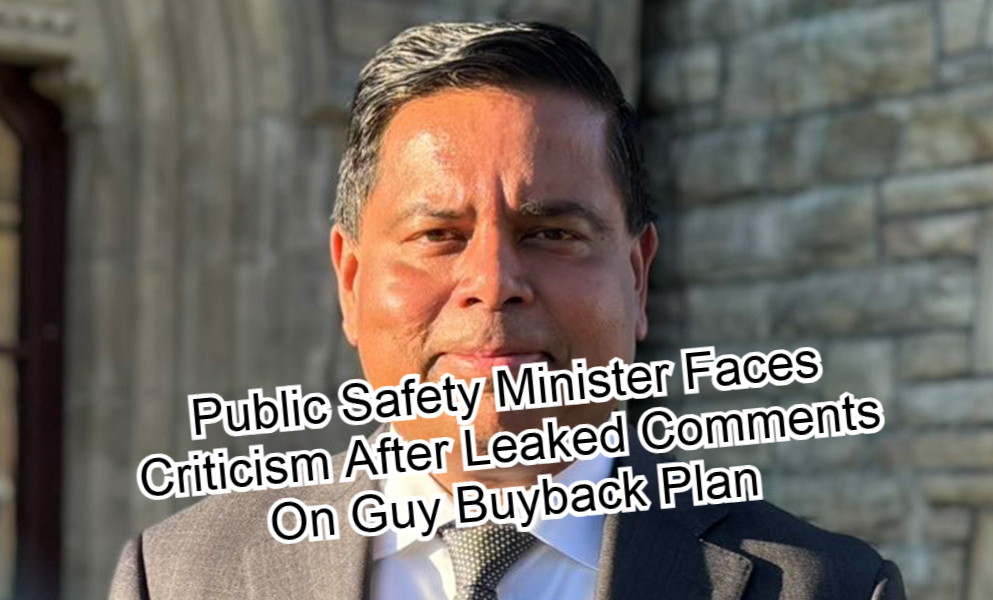Public Safety Minister Gary Anandasangaree is facing mounting criticism following the release of a leaked audio recording that appears to reveal his personal misgivings about the federal gun buyback initiative.
The recording, allegedly captured by a tenant residing in a property owned by the minister, features Anandasangaree expressing skepticism about whether local police forces are equipped to implement the program effectively. He also alludes to political pressure from Quebec as a driving force behind the policy, implying that the Liberal government is pushing forward to honor a campaign commitment.
In a moment of levity, the minister reportedly jokes that he would help bail out the tenant if they were arrested for intentionally flouting the rules.
Tracey Wilson of the Canadian Coalition for Firearm Rights said that Anandasangaree willingly engaged in a ten-minute conversation about the program, during which he acknowledged its flaws. According to Wilson, the minister even suggested that, given the chance to start over, he might abandon the initiative altogether and instead focus on cracking down on illegal firearms.
The buyback plan has long been a target of criticism, particularly from Conservative voices who argue that it unfairly penalizes responsible gun owners while failing to address the root problem of criminal gun activity.
CCFR's Tracey Wilson Reviews The Leaked Audio
Political Implications of the Leaked Audio
1. Credibility Crisis for the Gun Buyback Program
-
The minister’s apparent doubts about the feasibility and enforcement of the buyback initiative undermine the government’s public messaging.
-
If a senior cabinet member privately questions the program’s effectiveness, it raises concerns about internal coherence and policy integrity.
-
This could embolden critics who argue the program is more symbolic than practical.
2. Fuel for Opposition Attacks
-
Conservatives have long framed the buyback as a “gun grab” that punishes lawful gun owners. This leak hands them fresh ammunition.
-
Expect intensified scrutiny in Question Period and campaign messaging, especially in rural and suburban ridings where firearm ownership is more common.
3. Quebec’s Influence and Regional Tensions
-
The minister’s reference to Quebec’s political pressure could stir resentment in other provinces, especially those already skeptical of federal overreach.
-
It may also revive debates about regional favoritism and the role of Quebec in shaping national policy.
4. Impact on Liberal Cohesion and Messaging
-
If more internal dissent surfaces, it could fracture the party’s unity on gun control — a key plank in their public safety agenda.
-
The Liberals may need to recalibrate their messaging or risk appearing out of touch with both their own ministers and the broader public.
5. Trust and Transparency Concerns
-
The casual tone of the minister’s remarks — including the joke about bailing out someone who breaks the law — could be seen as flippant or dismissive.
-
This risks eroding public trust in the seriousness with which the government approaches firearms policy and law enforcement.
6. Strategic Reassessment Ahead of the Next Election
-
With the next federal election on the horizon, the Liberals may be forced to reconsider the buyback’s political cost.
-
If internal polling shows the issue is alienating swing voters or energizing opposition bases, they might pivot toward more targeted anti-crime measures.
Comparing the Trudeau-Carney Liberal Gun Buyback Plan to the Chretien Era Long Gun Registry
Similarities
1. Liberal Party Sponsorship
-
Both initiatives were introduced by Liberal governments as part of broader gun control efforts.
-
Each was framed as a public safety measure aimed at reducing gun violence.
2. Controversial Reception
-
Both policies sparked intense backlash, especially from rural communities, firearm owners, and Conservative politicians.
-
Critics argued that the measures targeted law-abiding citizens rather than criminals using illegal firearms.
3. Enforcement Challenges
-
The long gun registry faced logistical hurdles in registering millions of firearms.
-
The buyback program now faces similar concerns about enforcement, especially at the municipal level, as highlighted in the leaked audio involving Minister Anandasangaree.
4. Regional Tensions
-
The registry was seen as disproportionately affecting Western and rural provinces.
-
The buyback program has also stirred regional sensitivities, particularly with Quebec’s influence being cited as a driving factor.
Differences
| Feature | Long Gun Registry (1995–2012) | Gun Buyback Program (2020–Present) |
|---|---|---|
| Policy Mechanism | Mandatory registration of non-restricted firearms | Mandatory surrender and compensation for newly prohibited firearms |
| Cost Overruns | Promised at $2M, ballooned to ~$2B | Costs still unfolding; critics fear similar overruns |
| Public Disclosure | Registry data was kept and allegedly misused even after repeal | Buyback details are still being finalized; transparency concerns persist |
| Legal Status | Registry was repealed by Conservative government in 2012 | Buyback is ongoing; implementation delayed and criticized |
| Cultural Framing | Seen as bureaucratic overreach and a “symbolic” gesture | Framed as a response to mass shootings and public pressure, especially post-2020 ban |
Political Lessons and Legacy
-
The long gun registry became a political liability for the Liberals, especially in Western Canada, and contributed to the rise of populist opposition movements like the Reform Party.
-
The current buyback program risks repeating history if it’s perceived as ineffective, costly, or politically motivated — particularly given the leaked audio suggesting internal doubts and regional pressure.
Timeline: Long Gun Registry vs. Gun Buyback Program
Jean Chrétien’s Long Gun Registry (1995–2012)
-
1995: Bill C-68 passes, creating the Firearms Act and mandating registration of all firearms, including non-restricted long guns.
-
1996–2002: Implementation struggles with cost overruns, technical issues, and resistance from gun owners.
-
2002: Auditor General reports the registry cost nearly $1 billion — far above initial estimates.
-
2006: Stephen Harper’s Conservative government begins dismantling the registry.
-
2012: Registry officially scrapped for non-restricted firearms; data deleted (except in Quebec, where legal battles ensue).
Trudeau-Carney’s Gun Buyback Program (2020–Present)
-
May 2020: Following the Nova Scotia mass shooting, the Liberals announce a ban on over 1,500 models of “assault-style” firearms.
-
2021: Buyback program announced to compensate owners for turning in banned firearms.
-
2022–2024: Delays in rollout; questions arise about logistics, costs, and enforcement.
-
2025: Leaked audio from Minister Anandasangaree reveals internal doubts, reigniting debate.
Public Opinion: Then vs. Now
| Era | Public Sentiment | Key Divides | Political Fallout |
|---|---|---|---|
| 1990s–2000s | Mixed but increasingly negative as costs ballooned | Urban vs. rural; East vs. West | Contributed to Liberal losses in Western Canada |
| 2020s | Polarized; support for bans after mass shootings, but skepticism about buyback logistics | Law-abiding owners vs. anti-gun advocates; regional tensions | Risk of alienating swing voters and energizing Conservative base |
What’s Changed?
-
Technology & Transparency: Today’s digital landscape means leaks (like the Anandasangaree audio) spread instantly, amplifying backlash.
-
Framing: The registry was seen as bureaucratic; the buyback is framed as moral and reactive to tragedy — but both face accusations of symbolism over substance.
-
Political Landscape: The rise of populist and regional parties has made gun control a wedge issue, especially in provinces like Alberta and Saskatchewan.
Conclusion: Gun Control, Political Fallout, and Historical Echoes
Today’s deep dive into the leaked audio involving Public Safety Minister Gary Anandasangaree revealed more than just a moment of political vulnerability — it opened a window into the broader tensions surrounding the Liberal government’s gun buyback program. The minister’s candid remarks, captured by a tenant, cast doubt on the program’s enforceability and hinted at regional political pressures, particularly from Quebec. These revelations have intensified criticism from Conservative voices and reignited debates about the program’s legitimacy and effectiveness.
We then examined the political implications of this controversy, highlighting how it threatens the Liberals’ credibility, fuels opposition attacks, and risks alienating key voter blocs. The buyback’s resemblance to the Jean Chrétien-era long gun registry — another Liberal-led initiative that faced fierce backlash — underscores the cyclical nature of gun control politics in Canada. Both policies were framed as public safety measures but struggled with cost, enforcement, and public trust.
By comparing timelines and shifts in public opinion, we saw how gun control has evolved from a bureaucratic registry to a reactive ban-and-buyback model. Yet the core challenge remains: balancing safety with fairness, and symbolism with substance.
As the next election looms, the Liberals face a familiar crossroads — whether to double down on a controversial policy or pivot toward more targeted, pragmatic solutions. The echoes of past missteps are loud, and the political stakes are high.










